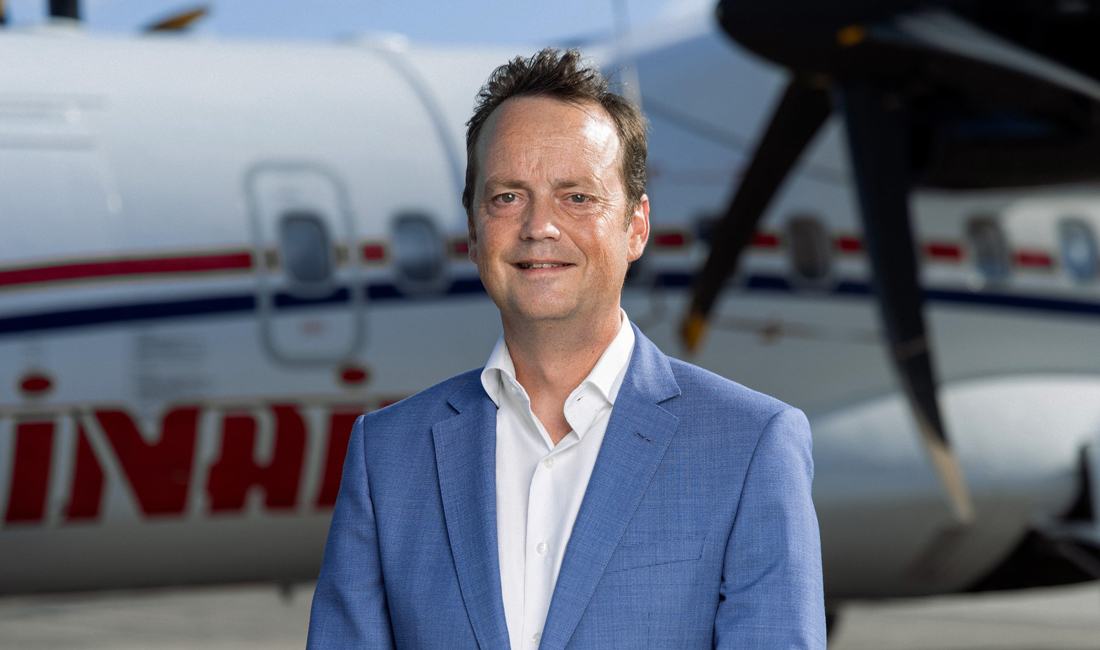
24 Jun Interview with Hans van de Velde, Winair, Sint Maarten
Could you introduce Winair and specifically your history and current operations connecting Sint Maarten and the Leeward Islands?
We’ve been in operation for 64 years. When we started, there were many airlines with small aircraft connecting the islands around us, but most of them failed. Our success has come from being cautious and not too aggressive or overly optimistic. Over time, we grew steadily into a mid-sized airline with eight aircraft. We currently have five 20-seaters and three 50-seaters, which may seem small, but for this region with its many small islands, it’s the perfect size. For example, the neighboring island of Saba has just 2,000 inhabitants and we still operate three flights a day with our 20-seater. A larger aircraft wouldn’t be practical for that route.
We serve as a link between the Caribbean and the rest of the world, operating to 16 destinations in the region. Our strength lies in two main factors. First, we have strong commercial partnerships with other airlines, such as United, JetBlue, KLM, Air France and British Airways. Even though British Airways doesn’t fly to Sint Maarten, they operate in Antigua and we transport their passengers from there to Sint Maarten. Similarly, Air Caraïbes, a French airline, doesn’t operate to Sint Maarten, but they fly to Martinique, where we also operate, allowing us to pick up passengers from there as well. This connectivity is vital for our business model, as we couldn’t fill our aircraft with local passengers alone, we rely on a mix of residents and international tourists.
Running an airline in this region is challenging due to weather conditions, but our second strength is our commitment to punctuality. In this region, many flights are often rerouted or canceled, but we do everything we can to avoid that. We operate very successfully and are currently a team of 200 employees, with plans to grow to 250 this year.
What are your plans for electric flying?
Sint Maarten is an ideal location for electric flying. We have nearby destinations like Sint Eustatius, Saba, St. Barts and Anguilla, all of which are within a 20-minute flight and represent a market that could benefit from electric aviation. We’ve attended several conferences and had discussions with startup initiatives and while electric flying is coming, I’m not as optimistic as some of the startups that think it will happen in just two years. For me, the real question is whether it will happen by 2035 or sooner.
For example, Anguilla is only about five miles away and it’s currently served by very small aircraft carrying between 8 to 20 passengers, making it perfect for electric flying. The same goes for St. Barts, which is also very close and has frequent flights. However, after speaking with the initiatives developing electric aircraft, it’s clear that there’s still work to be done. These are small airlines operating at small airports with short runways and developing an electric aircraft that can operate on these short runways is a major challenge. In conventional aviation, very few aircraft can even operate at these types of airports. We are very open to the idea of electric flying. Flying in this region is expensive because of the low population density, which means more aircraft per person, driving up costs. If electric flying can offer a similar cost, I’ll be the first to embrace it.
Are you planning to increase the number of partnerships that you have at the moment?
The partnerships we have are crucial to our success. For example, we’ve had a longstanding partnership with United and Air France for over a decade, while our collaboration with JetBlue is newer, only two years old, however, we can already see great results from this partnership for both sides. We are open to expanding these relationships further. Currently, we’re in talks with airlines from South America who are considering flying to Sint Maarten. So yes, we are very open to new partnerships and it’s in our DNA to work like that.
In September, the Sint Maarten government, which holds a 94 percent stake in Winair, announced it would not proceed with any sale, as the offers received were too low and not in the best interest of the airline. What message would you share with readers in the Miami and South Florida area who might be interested in exploring this opportunity?
We are government-owned, but in a positive way, as the government acts as a shareholder. We have an annual shareholder meeting, but they don’t influence our day-to-day operations; we run the business independently. We’re a profitable business and financing is key for growth in aviation. Aviation is often seen as a risky investment because many airlines in the region go bankrupt. However, with our 63 years of history, we’ve proven that success is possible.
Since 2016, we’ve shown consistent growth, despite setbacks like Hurricane Irma and COVID-19. I’m not unhappy with the current government as a shareholder, but if there were more funds available to accelerate our growth, that would be welcome. Aircraft are costly and we currently finance our growth. The government of Sint Maarten doesn’t have abundant resources to support us, so additional financial support would allow us to grow more quickly.
What future expansion plans do you have or would you like to have and what opportunities could you pursue that are currently challenging as a result?
We’ve recently expanded our fleet with the addition of Twin Otters, which are 19- or 20-seat aircraft and we now have five of them. The focus with the Twin Otters is on electrification, as they are designed for short flights, typically no more than half an hour. We might add a sixth one, but beyond that, there’s no major growth planned in terms of aircraft type. Electrifying these smaller aircraft could be a significant step forward.
In addition to the Twin Otters, we have three ATR turboprops, each seating 50 passengers. This size is perfect for the region. We’re adding one of these 50-seat planes each year, which shows we are able to fill them. As a result, our network is expanding and we’re now serving 16 destinations, with plans to grow further. If we can speed up this growth, that would be great. The 50-seater is an ideal size for our needs. We’re not looking to invest in larger jets because we recognize our position in the market. As a regional carrier, we’re not trying to compete with the big U.S. airlines. Instead, we focus on feeding into the networks of larger carriers. For instance, Air France brings passengers from Europe to Sint Maarten and we transport thousands of those passengers to other destinations in the region. That’s how our business model works and that’s why we’re able to keep growing.
Airlines around the world are under pressure to reduce their carbon footprint. Apart from electric flying, what other green initiatives do you have in mind for Winair?
Many airlines talk about sustainability, but often it’s more about public relations than actual change. Take our Twin Otters, for example. You can either buy or lease them, or purchase new ones. A new Twin Otter saves about one percent in fuel compared to a 30-year-old one. So, in terms of fuel efficiency, the difference is minimal unless we make a real leap to electric flying. For the average customer in Sint Maarten, flying is expensive. Any initiative that increases operating costs makes the airline more vulnerable. Sustainability is particularly important in the region because these islands are directly impacted by climate change. However, it’s not a top priority for most people here; they’re more concerned with basic needs like the cost of living, hospital conditions and infrastructure.
For sustainability to truly develop, it needs to come from the government, as the aviation industry in this region is too vulnerable to push these initiatives on its own. Caribbean Airlines and our airline are the only two that have managed to survive in recent years, while others have failed. We are taking small steps. For instance, when we purchase new catering trucks, we opt for electric ones. These small efforts may not be game-changers, but they matter. The real breakthrough will come with electric flying. Sustainable aviation fuel sounds good, but when you consider the massive land area needed to produce it, it seems unlikely to become a widespread solution. What we need are technological breakthroughs. In the short term, I don’t expect much more than small initiatives in this region. We’re doing our best to reduce our carbon footprint, but it’s in small percentages.
Many customers believe aviation is going green because they see flights using sustainable fuel, but in reality, 80-90 percent of these efforts are just a façade. It’s essential to focus on the small initiatives. Some larger airlines have invested in electric ground equipment, which is great and helpful. But in Sint Maarten, our electricity network isn’t always reliable. We rely on our generator to keep operations running smoothly. To be truly sustainable, we need reliable infrastructure. It will happen and Sint Maarten could lead the way in this region, but it will take time — probably more than the optimists expect.
What is your final message for our readers?
Sint Maarten is known, but it could be stressed more. The food on the French side is incomparable to the rest of the Caribbean. It’s great to have the possibility to have the local Caribbean food, but in the French part you can eat the way the French do and that as a tourist is a great addition to what you find in other parts of the Caribbean. The touristic infrastructure here compared to the other islands it’s good.
Sint Maarten is a great place to visit not only during winter times, because somehow, it’s a destination between November and April, but also in May, June, July and August it’s still a beautiful destination to visit. The temperature is nearly flat all year round. One of the upsides of Sint Maarten is it’s the biggest hub in aviation, so, if you go to the Caribbean, the most connections are from Sint Marten. If you want to visit another island or you want to visit more islands than Sint Maarten is the ideal place to do it from.


Sorry, the comment form is closed at this time.